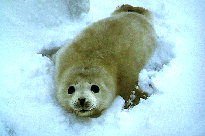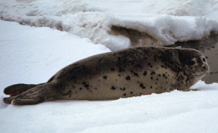Spotted Seal
(Phoca largha)
IUCN STATUS (2010) - DATA DEFICIENT
| Distribution and Numbers Also known as the Larga seal, the spotted seal inhabits the ice and waters of the north Pacific Ocean and adjacent seas, being found along the continental shelf of the Beaufort, Chukchi, Bering and Okhotsk Seas and south to the northern Huanghai Sea and western Sea of Japan. There is no up-to-date reliable census information on the total population of spotted seals. An estimate, now thought to be excessive, of 335,000 - 450,000 was made in the 1970s, of which 200,000 - 250,000 were reckoned to inhabit the Bering Sea. A Russian survey in 1986 and 1987 produced an estimate of 50,000 seals in the Okhotsk Sea. |
 Photo: Lloyd Lowry / Kathy Frost, Alaska Department of Fish and Game |
| Status The lack of accurate population data means that the effects of natural events and human-caused activities on the species are difficult to determine. There is concern however about the effects that climate change in the Arctic may have on the species. Spotted seals spend much of their time and bear their pups on the ice front, at the southern edge of the sea ice. In the case of global warming, this may cause a retreat of the ice edge and front, thus changing seal distribution relative to the distribution of prey, particularly if the seals are forced to move north and the good feeding areas stay where they are. |
| There is also some concern that oil and gas exploration and extraction in many parts of the species' range, particularly in the Chukchi and Beaufort Seas, may cause disturbance to spotted seals as well as possible pollution of the seals, their habitat and food supply. It has recently been reported that the waters off the Russian Sakhalin Island in the Okhotsk Sea, an important breeding site for the spotted seal, are about to be opened up to massive oil and gas development, and that tanker traffic and the extreme weather conditions in the area may lead to a major spill there. Potential pollution and disturbance from vessel traffic on the proposed Northern Sea Route is also a cause for concern. |
| Commercial fishing of spotted seal prey in the Bering Sea, particularly pollock and herring, may be causing problems by reducing food availability, a problem that may already be affecting Steller sea lions, harbour seals and Northern fur seals in the region. There is a limited bycatch of spotted seals by fisheries operations, and some fishermen are also known to shoot seals which try to raid fishing nets. Russian hunters kill spotted seals to be used as food on fox fur farms and for subsistence purposes, one estimate of the annual kill being around 2,500 with a maximum quota of 15,000. In the mid-1990s Alaskan native subsistence hunters were known to be killing about 2,000 spotted seals each year, mostly in the Bering Strait and Yukon-Kuskokwim regions. |
 Photo: Lew Consiglieri, National Marine Mammal Laboratory |
There is no longer a Japanese commercial spotted seal hunt but some seals are still hunted on an ad-hoc basis when ice conditions allow. Many seals also die in salmon trap nets along the Nemuro Peninsula. The spotted seal is listed as a nationally endangered animal in China, being the only pinniped that breeds in that country. The Chinese government is currently considering proposals that the Dalian Seal Sanctuary, a nature reserve established in 1992 at Liaodong Bay in the Bohai Sea and the only Chinese breeding site of the spotted seal, be upgraded to national status. Spotted seals in China are currently under threat from illegal hunting and capture, entanglement in fishing nets, loss of habitat, shortage of food and disturbance. |
| Lifestyle During the breeding season, which takes place in the spring, spotted seals are to be found at the southern edges of the pack ice, dependent on openings between ice floes for access to air and the ice surface. Known breeding areas are in the Bering Sea, Okhotsk Sea, Sea of Japan and Bohai Sea (where some seals give birth on land). Groups of three seals are often seen together on the ice in the early spring, consisting of a female, her mate and her new pup from her mate of last season. It is thought that the male joins the female about 10 days before she gives birth and mates with her, probably underwater, after her pup is born. Pups are born from February to May, depending on location, with a woolly white coat. The pup moults this coat after 4-6 weeks (2-3 weeks in Japan) at about the time that it is weaned. The pup usually stays out of the water for the first few weeks. However if it is forced to then it is able to swim, not too well, during this period. A month after it has weaned, the pup is able to dive to depths of at least 80m in order to feed. |
| Spotted seals gather in late spring-summer among the ice remnants, sometimes on land when ice is unavailable, to moult. There is a large variation in the colour of the adult spotted seal coat but generally it is silvery-grey with dark grey on the back and covered with brown to black spots. In the summer the seals move to the coasts as the sea ice retreats. Spotted seals in the Okhotsk Sea and Bering Seas disperse in all directions, some up to the Beaufort and Chukchi Seas, while in the Bohai Sea the migration is to the south and east. Not much is known of the distribution and movements of spotted seals during the autumn and winter months, but it is thought that they might stay in the water during this period. |
| The spotted seal is closely related to and shares some habitat with the harbour seal (Phoca vitulina). Although the biology and habits of these two species differ, there is some evidence of inter-breeding. The diet of the spotted seal varies geographically, seasonally and by age, but it is known to include crustaceans, cephalopods and fishes such as herring, capelin, pollock, eelpout, sand lance and cod. Known predators are sharks, killer whales, walruses, Steller sea lions, polar bears, brown bears, wolves, foxes and some large birds. |
| Statistics There is some variation in spotted seal size between different populations. Adult males measure 1.5-2.1m in length and weigh 85-150kg, while adult females measure 1.4-1.7m in length and weigh 65-115kg. Pups are born measuring 75-90cm in length and weighing 7-12kg. The pup mortality rate for the first year is around 45%. Adult spotted seals can dive to depths of over 300m. Females reach sexual maturity at 3-4 years of age, males at 4-5 years. Spotted seals can live to at least 35 years of age. |
 Photo: Lloyd Lowry / Kathy Frost, Alaska Department of Fish and Game |
